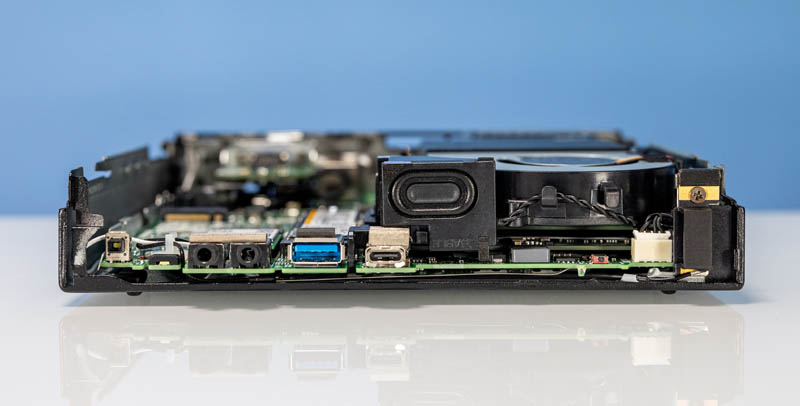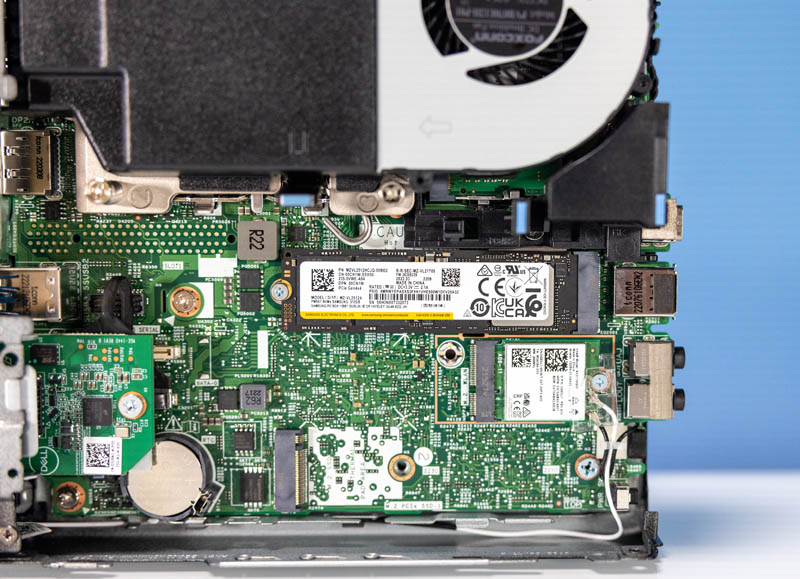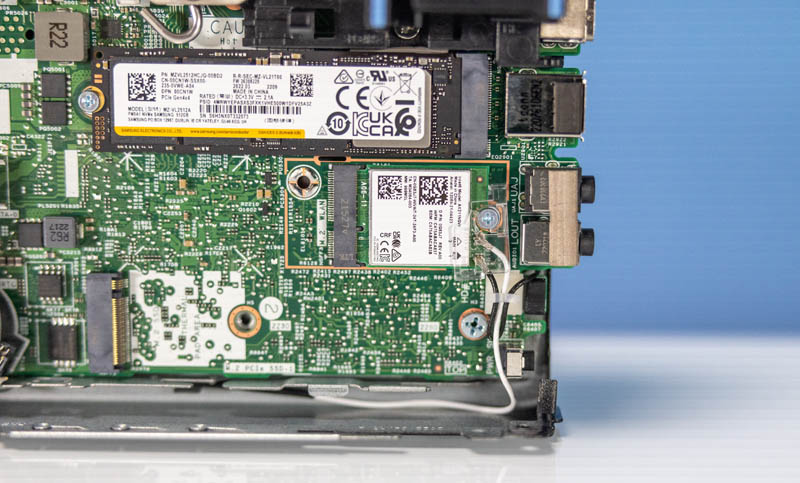Dell OptiPlex 7000 Micro Internal Hardware Overview
Getting inside the system, Dell has a class-leading single retained screw solution. There is also a nice power cable holder hook that seems to have undergone a small but useful redesign (we close the chassis less with this one out of place as a result.) Here is a look at Dell’s design which is similar to the layout of the HP Mini competition and less like the Lenovo Tiny units.

One of the fun features is that our system had an optional speaker. Do not expect to DJ at a large event or get theatre-quality audio from this. It is, however, good for things like notifications.

Taking off the fan and shroud, we can see inside the unit with the major components.

On the top, we have a socket LGA1700 with the Intel Core i7-12700 Alder Lake CPU. One can even see the socket latch from here.

Next to the CPU, we have the two SODIMMs. The 65W chassis uses DDR5 memory and so we have two DDR5 SODIMMs that are 8GB each. The system can support up to 64GB in 2x 32GB configurations.

One area where we wish Dell would improve is the heatsink. The heatsink on some competitive units is copper. This is not as dense. As a result, later in our power consumption figures, we will discuss the impact. Also, in the video for this, we show the impact of thermal throttling.

Below the CPU, memory, and cooling, we have the main expansion area.

Our SSD was a Samsung PCIe Gen4 NVMe SSD that is 512GB. This is an upgrade in the chassis. We also managed to hit some fairly significant temperatures on this SSD in this chassis that we will discuss later.

The WiFi solution is an Intel AX211 WiFi 6E/ Bluetooth card. WiFi is optional on these units. If you do configure one, The Intel AX211 would be our recommendation over the other offerings.

On the bottom of this area, we get a second M.2 NVMe slot.

Over the battery, we can see the optional HDMI expansion port PCB.

Above that, we can see pads for “Slot 1” but an unpopulated slot. We did not see the dGPU option, but we suspect that is what these pads are for.

One item we did not get with this system was a 2.5″ tool-less caddy. Storage these days is moving to M.2 and Dell has cooling challenges anyway in this form factor. Removing the 2.5″ drive infrastructure also meant Dell could remove the hard SATA data and power connector on the motherboard that was a class-leading solution in the previous generation.

One can also see the Intel vPro sticker on the bottom of this unit. Intel vPro is optional, but one can also order these without vPro.
Next, let us get to the performance with some special results.




Pat that SSD is actually just a OEM 980 Pro. So it’s pretty much top bin from Samsung
Once you factor in that power brick I think I prefer the next size up (small form factor). Slightly bigger package if compared to micro+power brick but you get internal power supply and half height expansion slot.
Dave – that is totally the case. Note the thermal results of the SSD.
Nice review. I wonder which tpm chip is used? Taiwan?
Pat – Right! I realized that was the results because it’s throttling.
Hello Pat, appreciate the great write up as usual. Just curious if you had a second m.2 NVMe SSD and was able to get it to detected in AHCI mode? Thank you!
No option for 2.5/5/10gig ethernet in 2022? feels like a limitation, esp compared to 2018 mac mini.
Dell should make a Ryzen 7000 version. Ditto altmind’s call for 10Gb.
I thought these were all the low power “T” variants?
This one appears to be i7-12700, but most I look at are i7-1200T.
I just love those small boxes for the idle vs. peak power they can deliver!
I’d have a couple of questions:
Does the BIOS support setting P1/P2/TAU so you can balance peak heat/noise better?
Is it worth trying to find a TDP setting that just stays shy of throttling or will throttle have the same effect?
My understanding was that the orignal throttling was rather drastic and would literally stop the clock for what could amount to milliseconds, whilst e.g. a Ryzen will simply lower the clock to the point where 90°C won’t be exceeded. Apart from noise issues the latter would certainly seem much better for not missing interrupts, real-timish audio/video playback or even avoiding dropped network packets.
While these units are obviously designed for desktop use, I am assuming your interest like mine is primarily in server use. But there at least one 10GBit Ethernet port or a Thunderbolt port to connect one would seem minimum to balance the speed and throughput these devices are capable of. Well in fact these should be able to hold their own even on 40Gbit…
With multiple USB 10Gbit ports and some even at 20Gbit, some sort of faster fabric seems urgently missing.
A product at that price point, shouldn’t be limiting the type-C port to just USB, but also include thunderbolt functionality.
Have anyone tried to run a raid card through the m.2 to PCIe raiser adapter?
Missing thunderbolt is for me a huge nono
Thunderbolt would allow an external gpu to take the heat and do more with the micro pc
I wonder who makes these devices without realizing they are missing something important
I recently go one 7050 pre- knowed after a few months it crash, timing settings . repeating shut down mode. Never recovered from the crash . retried to re-install window s 10 crash right after bootup. Trash . may inspiron 1400 laptop runs like a dream . faster than that tiny PC.